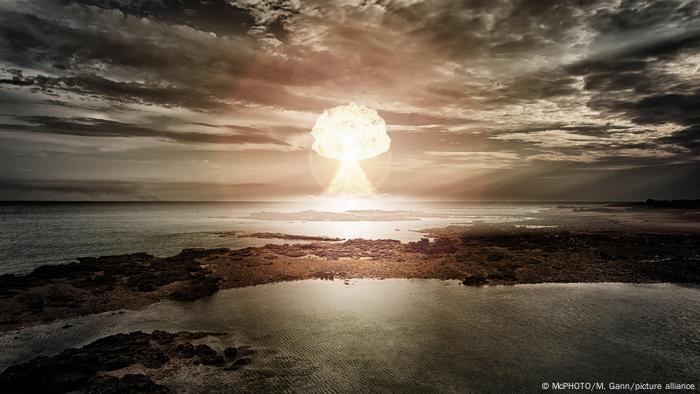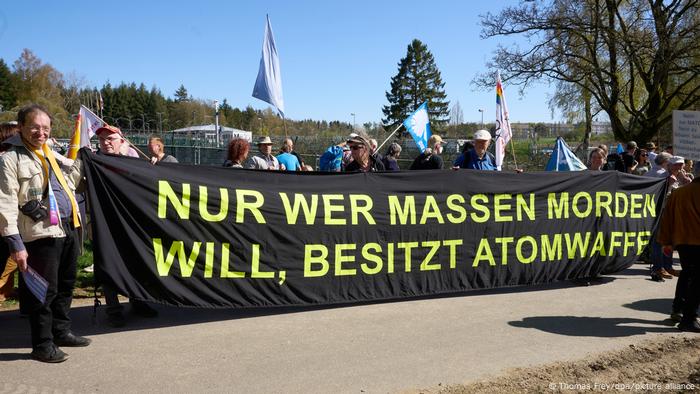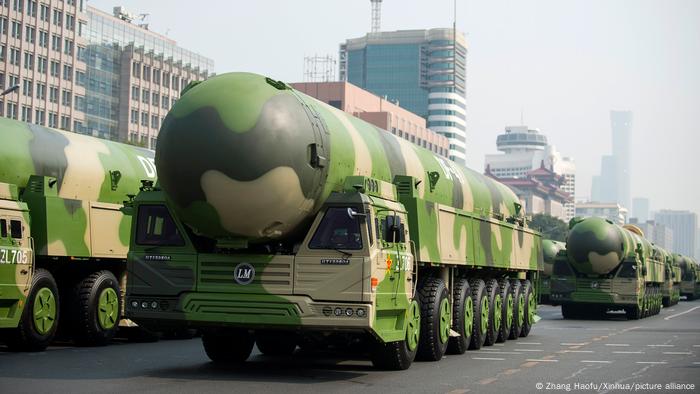Germany does not have nuclear weapons itself, but is part of the US nuclear strategy. The balancing act was successful for a long time. But the Ukraine war and dwindling arms controls call it into question.

Still a nightmare scenario: nuclear explosion, here over the ocean
If the Cold War had been fought nuclear, it would probably have started on German soil. Geographically, Germany lay between the United States and its NATO allies on one side and the Soviet Union and the Warsaw Pact countries on the other. The country was politically divided into West and East. Strategically, the American and Soviet military faced each other here – on their respective sides of the Iron Curtain.
The Federal Republic (FRG) and the German Democratic Republic (GDR) acted as a kind of nuclear buffer between the warring superpowers. Germany still benefits today from the supposed security of the US nuclear shield, but also sees the danger of one exposed to immediate nuclear escalation.

Easter March 2022: There are repeated protests in Büchel against the stationing of US American nuclear weapons
A strong peace movement has developed in the former West Germany, and many of its supporters are pushing for speedy negotiations with Russia in connection with the war in Ukraine. Many people in the former East Germany also take a less hostile attitude towards Russia than supporters of arms supplies . At the same time, there are many unreserved supporters of Ukraine in both East and West. These factors contribute to the fact that the issue of arms control is a particularly sensitive issue in Germany.
“Germany remains clearly committed to its commitment in the areas of arms control, disarmament and non-proliferation of nuclear weapons, even under the changed conditions,” the Foreign Office said when asked by DW – an allusion to the Russian invasion of Ukraine, which – some military analysts fear – could prompt Russian President Vladimir Putin to break the “nuclear taboo” should his conventional forces continue to struggle on the battlefield.

Peace movement: reminder on the 75th anniversary of the atomic bombing of Hiroshima
“Together with its partners, the Federal Government is unequivocally opposed to any relaxation of the taboo,” the Foreign Office said. This refers to the unwritten agreement not to use nuclear weapons. It developed after the USA double nuclear attack on Japan and the associated end of the Second World War in 1945.
Nuclear balancing act
Germany's negative stance on nuclear weapons conflicts with expectations that the country will support the security status quo. NATO's nuclear sharing policy – the US-led military alliance's long-standing policy of allowing US nuclear weapons to be stationed on non-US territory – means that German warplanes could carry nuclear weapons in the event of a nuclear war.
According to an estimate by the “Nuclear Threat Initiative”, there are up to 20 such warheads at the Büchel air base in western Germany. The in Washington D.C. The resident think tank had about 130 more at Ramstein Air Force Base until they were removed between 2001 and 2005.
The nuclear balancing act is creating tensions in both German domestic politics and the Euro-Atlantic Alliance. However, since the Russian war of aggression against Ukraine, all disagreements have receded into the background.
Russia moves nuclear weapons to Belarus
Some Green Party politicians, traditionally among the harshest critics of nuclear weapons in Germany, are also among the most vocal supporters of Ukraine in Germany. NATO officials, meanwhile, are using every opportunity to show that Russia's efforts to split the alliance have failed.
“We are clearly at a tipping point,” John Erath, senior policy director at the Center for Arms Control and Non-Proliferation, told DW. “One of the means that Russia has chosen to achieve its goal is the threat of using nuclear weapons.”
Nuclear threats – past and present
Russia has not yet achieved its goals of controlling Ukraine and breaking US and NATO support. Using nuclear weapons as a “diplomatic tool,” says Erath, has helped diminish that support. The US has been careful to avoid an escalation that could draw it into direct conflict with Russia. And German officials have often expressed concern that Germany might cross a border that would make the country an official war party.
“The real danger is that this conflict will end with Russia being perceived as successful and this instrument as effective. Because that opens the floodgates,” says Erath. Other nuclear states such as North Korea could resort to even more daring threats.
Such “nuclear diplomacy” has existed before. In the 1980s, renewed deployments of Soviet nuclear forces prompted NATO to respond accordingly. Large-scale protests, particularly in what was then West Germany, pressured the government to oppose the deployment of more US missiles in the country.

Demonstration against planned missile deployments in the Hunsrück in 1986
According to NATO, it was a “difficult time for both West Germany and NATO”. However, the alliance held out. A “two-pronged” compromise was found, which provided for more deployments, but also for negotiations with the Soviet Union on arms control.
“Differences in the perception of nuclear dangers among NATO allies can be a critical point for Russia that it could exploit,” says Jonas Schneider of the Berlin think tank Stiftung Wissenschaft und Politik (SWP). “All in all, Germany is taking a more cautious stance with regard to nuclear risks.”
Nuclear weapons control: 10 percent missing
However, arms control in the form of treaties has hit rock bottom since Russia suspended, but did not cancel, the “New START” treaty, the last major agreement limiting Russian and American strategic arms. Security experts like Schneider are therefore relatively confident, at least in the short term. “All in all, I don't see any increase in nuclear risk as a result of what happened with New START,” he says.
That's partly because treaties are just one element of arms control. Transparency, dialogue and data collection on public and secret channels are further elements. Nuclear weapons are expensive and conspicuous, so changes in numbers or deployment are relatively easy to spot.
In addition, the treaties only apply to the Russian and American armed forces. They control about 90 percent of the world's nuclear weapons. The fact that China is not part of these treaties is considered a serious problem.

New superpower? Chinese Dongfeng-41 missiles – presented at a military parade
There are several small and medium-sized states with nuclear weapons, but according to Erath it is China “where things are changing in the nuclear world”. In addition, the United States lacked the understanding and communication channels that have been built up with Russia over decades.
Most countries do not have nuclear weapons, 92 of them have even signed the nuclear weapons ban treaty. However, with none of the world's nuclear powers on board, the deal is largely symbolic.
Germany, which supports the movement to abolish nuclear weapons but is committed to US nuclear doctrine, is now trying to do two things at once to do. In 2022, Germany attended a treaty meeting in Vienna as an observer – a sign that anti-nuclear aspirations are competing with real nuclear commitments.
This text was adapted from English.